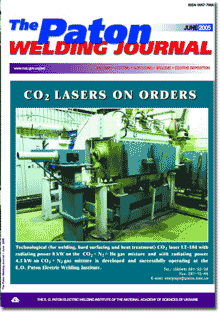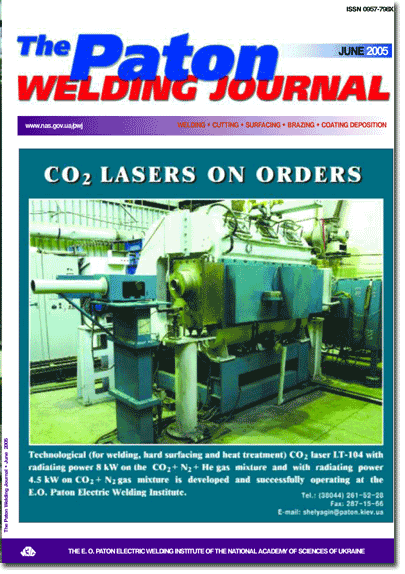

| SCIENTIFIC AND TECHNICAL | |
| Yushchenko K.A., Savchenko V.S., Chervyakova L.V., David S. and Vitek J. Investigation of weldability of nickel superalloys and development of repair technology for gas turbine blades | 2 |
| The paper describes studies on evaluation of weldability of nickel-base superalloys applied in manufacture of gas turbine blades. The content of the strengthening gВ-phase in the alloys reaches 60 %. A technology is proposed for repair of blades by plasma powder cladding. | |
| Borisov Yu.S., Zatserkovny A.S. and Krivtsun I.V. Convective-conductive and radiation heat exchange of plasma flow with particles of dispersed materials in plasma spraying | 6 |
| Physical processes are described, which determine the thermal impact of the plasma jet on dispersed material particles in plasma spraying of coatings. Various criterial dependencies are analysed, which are used for calculation of the convective-conductive component of the heat flow through the surface of a spherical particle in the flow of a low-temperature plasma at atmospheric pressure. A procedure is proposed for calculation of characteristics of radiation heat exchange of dense plasma with the metal particle surface. Numerical analysis of the considered components of the heat flow into a particle has been conducted in a broad range of parameters of a non-disturbed plasma flow (argon plasma) and temperature of the particle (aluminium) surface. It is shown that the radiation heat exchange has a significant influence on the resulting heat flow through the surface of a spraying particle. | |
| Pentegov I.V., Petrienko O.I., Pustovojt S.V.,Sidorets V.N. and Lavrenyuk A.V. Determination of voltage drop in the area of electrode wire contact with the welding torch nozzle under mechanized methods of arc welding | 10 |
| Experiments are described on determination of voltage drop in the area of electrode wire contact with the welding torch nozzle. Results of computer processing of experimental data were the basis to suggest empirical formulas of contact voltage drop dependence on different welding parameters. | |
| Shlepakov V.N., Kotelchuk A.S., Naumejko S.M. and Bilinets A.V. Influence of the composition of flux-cored wire core and shielding gas on the stability of arc welding process | 16 |
| The paper presents the results of studying the process of gas-shielded arc welding with flux-cored wires of metal-core type. The influence of mineral components of the flux-cored wire core and shielding gas composition on arcing stability and nature of metal transfer has been established, proceeding from the data of monitoring electrical signals. | |
| Shejko P.P., Zhernosekov A.M., Lozovskaya A.V. and Shimanovsky Yu.O. Application of a two-channel system of automatic stabilization of pulsed-arc welding to improve the welded joint quality | 21 |
| Effectiveness of application of a two-channel system of automatic stabilization in consumable-electrode pulsed-arc welding of aluminium alloys under the impact of disturbing factors has been established experimentally. It is shown that the mechanical properties of butt-welded joints of AMg6 alloy produced by pulsed-arc welding deteriorate with increase of electrode wire extension and lowering of the mains voltage. Use of a two-channel system of automatic stabilization of pulsed-arc process allows ensuring the mechanical properties of butt-welded joints on the level of those obtained in optimum modes without disturbances. | |
| Ryzhov R.N. and Kuznetsov V.D. Choice of optimal parameters of external electromagnetic action in arc methods of welding | 24 |
| Dependencies are given which allow optimizing the parameters of electromagnetic action. Adequacy of the derived dependencies to the actual welding conditions is confirmed by comparative analysis of the calculated and experimental data. Analysis is performed of the influence of both the welding parameters and thermophysical properties of materials on the optimum range of the mode of electromagnetic action. | |
| INDUSTRIAL | |
| Bernadsky V.N. Steel and welding in construction engineering | 28 |
| In the paper modern civil engineering is presented as an independent sector in the economies of the world leading countries that is characterized by a growing application of steel metal products and welding equipment. Approximate scope of application of steel and steel metal products in the industrial and civil construction of several countries is evaluated. It is shown that welding and allied technologies are no-alternative processes of treatment and joining during fabrication and construction of steel building structures. Predicted tendencies of development of the sector of welding equipment in the world welding product market are outlined. | |
| Ryabtsev I.A. High-efficiency wide-layer surfacing using electrode wires and strips (Review) | 31 |
| Main methods for high-efficiency wide-layer surfacing using electrode wires and strips are described. Their advantages and drawbacks are considered. Examples of commercial application are given. | |
| Matveev V.V. Surfacing of train wheel flanges after annealing of the tread surface in car-repair plants of Ukraine | 36 |
| Features of wear of railway wheels and applied technologies of wheel flange reconditioning by surfacing are considered. Experience of reconditioning the wheel flanges after annealing of the tread surface is described. Advantages of such a technology of flange reconditioning are noted. | |
| Skulsky V.Yu. and Moravetsky S.I. Filler materials for automatic submerged-arc welding of heat-resistant 9%Cr steels | 42 |
| Developed filler materials for mechanized submerged-arc welding of heat-resistant steel with 9 wt.% Cr are described. It is shown that the mechanical properties of weld metal and welded joints of the above steel produced using the proposed welding consumables, meet the specified requirements. | |
| BRIEF INFORMATION | |
| Orlov L.N., Golyakevich A.A., Upyr V.N. andGiyuk S.P. Flux-cored wire for welding in shipbuilding | 44 |
| Self-shielded flux-cored wire for a wide application in shipbuilding is described. Composition and mechanical properties of the deposited metal, as well as delivery conditions are given. | |
| Thesis for a candidate of technical sciences degree | 45 |
| NEWS | 46 |
(You are viewing the simplified file contents)
The cost of subscription/purchase order journals or individual articles
| Journal/Currency | Annual Set | 1 issue printed |
1 issue |
one article |
| TPWJ/USD | 384 $ | 32 $ | 26 $ | 13 $ |
| TPWJ/EUR | 348 € | 29 € | 24 € | 12 € |
| TPWJ/UAH | 7200 UAH | 600 UAH | 600 UAH | 280 UAH |
| AS/UAH | 1800 UAH | 300 UAH | 300 UAH | 150 UAH |
| AS/USD | 192 $ | 32 $ | 26 $ | 13 $ |
| AS/EUR | 180 € | 30 € | 25 € | 12 € |
| SEM/UAH | 1200 UAH | 300 UAH | 300 UAH | 150 UAH |
| SEM/USD | 128 $ | 32 $ | 26 $ | 13 $ |
| SEM/EUR | 120 € | 30 € | 25 € | 12 € |
| TDNK/UAH | 1200 UAH | 300 UAH | 300 UAH | 150 UAH |
| TDNK/USD | 128 $ | 32 $ | 26 $ | 13 $ |
| TDNK/EUR | 120 € | 30 € | 25 € | 15 € |
AS = «Automatic Welding» - 6 issues per year;
TPWJ = «PATON WELDING JOURNAL» - 12 issues per year;
SEM = «Electrometallurgy Today» - 4 issues per year;
TDNK = «Technical Diagnostics and Non-Destructive Testing» - 4 issues per year.


